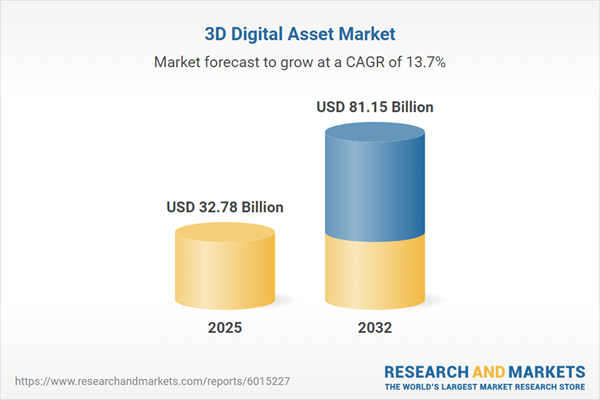Speak directly to the analyst to clarify any post sales queries you may have.
The 3D digital asset market is undergoing rapid evolution as immersive technologies transform how enterprises design, visualize, and collaborate across a broad spectrum of industries. For senior decision-makers, understanding the key drivers and strategic imperatives is essential to leverage these assets for improved product development, operational efficiency, and market differentiation.
Market Snapshot: 3D Digital Asset Market Size and Growth
The 3D digital asset market grew from USD 28.98 billion in 2024 to USD 32.78 billion in 2025. It is expected to continue growing at a CAGR of 13.73%, reaching USD 81.15 billion by 2032. Strong demand spans industries engaging in product conceptualization, marketing, simulation, and digital transformation strategies.
Scope & Segmentation: Strategic Focus Areas
- Component
- Hardware: 3D Scanners, Motion Capture Systems
- Services: Managed Services, Professional Services
- Software: 3D Animation Software, 3D Modelling Software, 3D Rendering & Visualization Software, 3D Scanning Software
- Application
- Digital Prototyping
- Product Visualization
- Simulation
- End User
- Advertising & Marketing
- Architecture & Construction
- Automotive
- Education
- Healthcare & Life Science
- Media & Entertainment
- Retail & eCommerce
- Region
- Americas: United States, Canada, Mexico, Brazil, Argentina, Chile, Colombia, Peru
- Europe, Middle East & Africa: United Kingdom, Germany, France, Russia, Italy, Spain, Netherlands, Sweden, Poland, Switzerland, United Arab Emirates, Saudi Arabia, Qatar, Turkey, Israel, South Africa, Nigeria, Egypt, Kenya
- Asia-Pacific: China, India, Japan, Australia, South Korea, Indonesia, Thailand, Malaysia, Singapore, Taiwan
- Notable Companies
- 3D Systems Corporation, Adobe Inc., Altair Engineering, Inc., Ansys, Inc., Autodesk Inc., Bentley Systems, CGTrader, Chaos Group, Dassault Systèmes S.E., Epic Games, Inc., Foundry Visionmongers Ltd, Hexagon AB, KeyShot Inc., Maptek, Marvelous Designer, Matterport, Inc., Maxon Computer GmbH, NVIDIA Corporation, Pilgway s.r.o., PTC Inc., SideFX, Siemens AG, Topcon Positioning Systems, Trimble Inc., Unity Technologies
Key Takeaways: Strategic Insights for Decision-Makers
- Breakthroughs in rendering, cloud, and machine learning are accelerating real-time collaboration and design iteration in the 3D digital asset market.
- Widespread adoption of virtual and augmented reality is broadening the impact of 3D assets beyond prototyping to training, storytelling, and engagement.
- Industry leaders are leveraging modular ecosystems and open standards to enhance interoperability, agility, and platform adoption for large-scale deployment.
- Demand for cross-disciplinary talent and strategic partnership is rising, underlining the need for upskilling and collaborative solution delivery models.
- Regional nuances, such as the Americas’ innovation culture, EMEA’s regulatory focus, and Asia-Pacific’s high-volume demand, are shaping investment priorities and go-to-market approaches.
Tariff Impact on Supply Chains and Production
New United States tariff measures introduced in 2025 have altered the cost dynamics of importing key hardware components, including high-precision scanners and motion capture systems. Companies are adapting strategies by shifting sourcing, increasing local production, and revising software licensing models. This has driven partnerships and subscription-based solutions to help balance feature needs with cost control and compliance.
Methodology & Data Sources: Rigorous Market Intelligence
This report employs a multi-stage research process, blending proprietary databases, industry publications, and structured executive interviews. Data triangulation ensures reliable quantitative insights, while advisory board reviews align findings with industry realities and strategic priorities.
Why This Report Matters
- Enables senior leaders to prioritize investments and partnership strategies based on credible, segmented intelligence across technology, use case, and regional factors.
- Equips teams to navigate evolving regulatory and supply chain contexts in the pursuit of greater operational efficiency and sustainable value creation.
- Guides cross-functional alignment by clarifying technology trends and competitive landscapes, ensuring long-term innovation planning remains actionable.
Conclusion
The 3D digital asset market is positioned for sustained transformation as emerging technologies and new business models reshape value delivery. Leaders who act on segment opportunities and collaboration dynamics will be best equipped to capture growth and foster resilience.
Additional Product Information:
- Purchase of this report includes 1 year online access with quarterly updates.
- This report can be updated on request. Please contact our Customer Experience team using the Ask a Question widget on our website.
Table of Contents
3. Executive Summary
4. Market Overview
7. Cumulative Impact of Artificial Intelligence 2025
Companies Mentioned
The companies profiled in this 3D Digital Asset market report include:- 3D Systems Corporation
- Adobe Inc.
- Altair Engineering, Inc.
- Ansys, Inc.
- Autodesk Inc.
- Bentley Systems
- CGTrader
- Chaos Group
- Dassault Systèmes S.E.
- Epic Games, Inc.
- Foundry Visionmongers Ltd
- Hexagon AB
- KeyShot Inc.
- Maptek
- Marvelous Designer
- Matterport, Inc.
- Maxon Computer GmbH
- NVIDIA Corporation
- Pilgway s.r.o.
- PTC Inc.
- SideFX
- Siemens AG
- Topcon Positioning Systems
- Trimble Inc.
- Unity Technologies
Table Information
| Report Attribute | Details |
|---|---|
| No. of Pages | 190 |
| Published | November 2025 |
| Forecast Period | 2025 - 2032 |
| Estimated Market Value ( USD | $ 32.78 Billion |
| Forecasted Market Value ( USD | $ 81.15 Billion |
| Compound Annual Growth Rate | 13.7% |
| Regions Covered | Global |
| No. of Companies Mentioned | 26 |









